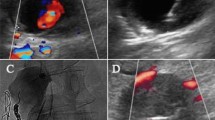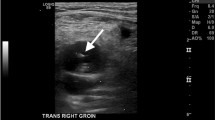Abstract
Background
Femoral pseudoaneursysm treatment is still controversial.
Aims
The aim of this study was to evaluate the anatomic features related to femoral pseudoaneurysm (FPA) closure failure for ultrasound-guided compression (USGC).
Methods
This was a single-center, prospective, cohort study. FPA patients admitted to the radiology department for USGC were included in the study. Age, sex, duration of FPA, thrombosis, ratio of thrombosis to FPA diameter, feeding artery, tortiosity, connection properties, length and width of the neck, volume, and fistula-to-common femoral artery (CFA) speed ratio were reported during color Doppler ultrasonography (CDUS) scanning.
Results
The study was completed with 192 patients. FPA compression therapy was successful in 155 patients and failed in 37 patients. FPA without a narrow connection (p < 0.001), FPA without existing thrombosis (p < 0.001), a lower thrombosis ratio (p < 0.001), a longer duration of FPA (p = 0.035), a shorter neck length, a wider neck width (p < 0.001), and a higher fistula-to-CFA speed rate (p < 0.001) were related to FPA closure failure with USGC. ROC analysis of the fistula-to-CFA speed ratio showed that a ratio of 1.01 had 47% sensitivity and 63% specificity for USGC treatment failure (AUC, 0.72; p < 0.05).
Conclusions
Failure of FPA closure with USGC is closely related to anatomic features of FPA. Evaluating the anatomical features of FPA before deciding the treatment method can be beneficial for patients and clinicians.


Similar content being viewed by others
References
Kontopodis N, Tsetis D, Tavlas E et al (2016) Ultrasound guided compression versus ultrasound guided thrombin injection for the treatment of post catheterization femoral pseudoaneurysms: systematic review and meta-analysis of comparative studies. Eur J Vasc Endovasc Surg 51:815–823
Katzenschlager R, Ugurluoglu A, Ahmadi A et al (1995) Incidence of pseudoaneurysm after diagnostic and therapeutic angiography. Radiology 195:463–466
Hessel SJ, Adams DF, Abrams HL (1981) Complications of angiography. Radiology 138:273–281
Schneider C, Malisius R, Küchler R et al (2009) A prospective study on ultrasound-guided percutaneous thrombin injection for treatment of iatrogenic postcatheterization femoral pseudoaneurysms. Int J Cardiol 131(3):356–61
ElMahdy MF, Kassem HH, Ewis EB et al (2014) Comparison between ultrasound-guided compression and para-aneurysmal saline injection in the treatment of postcatheterization femoral artery pseudoaneurysms. Am J Cardiol 113:871–876
Toursarkissian B, Allen BT, Petrinec D et al (1997) Spontaneous closure of selected iatrogenic pseudoaneurysms and arteriovenous fistulae. J Vasc Surg 25:803–808
Li Y, Chen SH, Spiotta AM et al (2021) Lower complication rates associated with transradial versus transfemoral flow diverting stent placement. J Neurointerv Surg 13:91–95
Papadakis M, Zirngibl H, Floros N et al (2016) Iatrogenic femoral pseudoaneurysm and secondary ipsilateral deep vein thrombosis: an indication for early surgical exploration. Ann Vasc Surg 34(269):e13–e15
Yang EY, Tabbara MM, Sanchez PG et al (2018) Comparison of ultrasound-guided thrombin injection of iatrogenic pseudoaneurysms based on neck dimension. Ann Vasc Surg 47:121–127
Ahmad F, Turner S, Torrie P et al (2008) Iatrogenic femoral artery pseudoaneurysms—a review of current methods of diagnosis and treatment. Clin Radiol 63(12):1310–1316
Coley BD, Roberts AC, Fellmeth BD et al (1995) Postangiographic femoral artery pseudoaneurysms: further experience with US-guided compression repair. Radiology 194:307–311
Eisenberg L, Paulson EK, Kliewer MA et al (1999) Sonographically guided compression repair of pseudoaneurysms: further experience from a single institution. Am J Roentgenol 173:1567–1573
Brummer U, Salcuni M, Salvati F et al (2001) Repair of femoral postcatheterization pseudoaneurysm and arteriovenous fistula with percutaneous implantation of endovascular stent. Nephrol Dial Transpl 16:1728–1729
Edgerton JR, Moore DO, Nichols D et al (2002) Obliteration of femoral artery pseudoaneurysm by thrombin injection. Ann Thorac Surg 74:1413–1415
Huang TL, Liang HL, Huang JS et al (2012) Ultrasound-guided compression repair of peripheral artery pseudoaneurysm: 8 years’ experience of a single institute. J Chin Med Assoc 75(9):468–473
de Oliveira Leite TF, Bortolini E et al (2019) Evaluation of morphological and clinical factors related to failure of percutaneous treatment with thrombin injection of femoral pseudoaneurysms from cardiac catheterization. Ann Vasc Surg 59:173–183
Şaylik F, Sevi̇mli̇ S (2022) Kardiyak Kataterizasyon Sonrası Gelişen Femoral Psödoanevrizmaların Ultrasonografik Kompresyon Yöntemiyle Kapatma İşlemi Sonrasındaki Kısa ve Orta Dönem Sonuçları. Acta Medica Nicomedia 5(3):157–164
Heis HA, Bani-Hani KE, Elheis MA et al (2008) Postcatheterization femoral artery pseudoaneurysms: therapeutic options. A case-controlled study Int J Surg 6:214–219
Kang SS, Labropoulos N, Mansour MA et al (1998) Percutaneous ultrasound guided thrombin injection: a new method for treating postcatheterization femoral pseudoaneurysms. J Vasc Surg 27:1032–1038
Franklin JA, Brigham D, Bogey WM et al (2003) Treatment of iatrogenic false aneurysms. J Am Coll Surg 197:293–301
Piedad BT, Kronzon I (2003) Iatrogenic femoral artery pseudoaneurysm. Curr Treat Options Cardiovasc Med 5:103–108
Lonn L, Olmarker A, Geterud K et al (2004) Prospective randomized study comparing ultrasound-guided thrombin injection to compression in the treatment of femoral pseudoaneurysms. J Endovasc Ther 11:570–576
Lönn L, Olmarker A, Geterud K et al (2002) Treatment of femoral pseudoaneurysms. Percutaneous US-guided thrombin injection versus US-guided compression. Acta Radiol 43:396–400
Popovic B, Freysz L, Chometon F et al (2010) Femoral pseudoaneurysms and current cardiac catheterization: evaluation of risk factors and treatment. Int J Cardiol 14(141):75–80
Shindo S, Kato K, Motohashi S et al (2007) Delayed femoral pseudoaneurysm formation after percutaneous coronary intervention. Clin Imaging 31:162–164
Author information
Authors and Affiliations
Corresponding author
Ethics declarations
Ethics approval and consent to participate
The principles set out in the Helsinki Declaration were followed. The informed consent was obtained from all patients.
Conflict of interest
The author declares no competing interests.
Disclaimer
This article has not been previously presented at any event (congress, symposium etc.).
Additional information
Publisher's Note
Springer Nature remains neutral with regard to jurisdictional claims in published maps and institutional affiliations.
Rights and permissions
Springer Nature or its licensor (e.g. a society or other partner) holds exclusive rights to this article under a publishing agreement with the author(s) or other rightsholder(s); author self-archiving of the accepted manuscript version of this article is solely governed by the terms of such publishing agreement and applicable law.
About this article
Cite this article
Havan, N. Influence of anatomical factors on the efficacy of treating femoral pseudoaneurysms with ultrasound-guided compression technique: A prospective cohort study. Ir J Med Sci (2023). https://doi.org/10.1007/s11845-023-03581-6
Received:
Accepted:
Published:
DOI: https://doi.org/10.1007/s11845-023-03581-6




